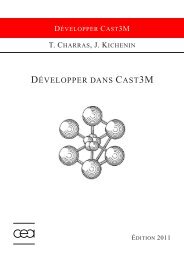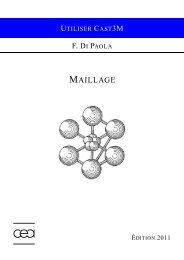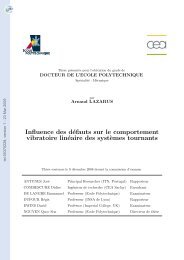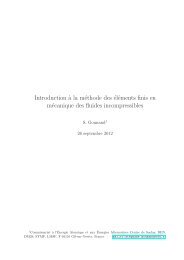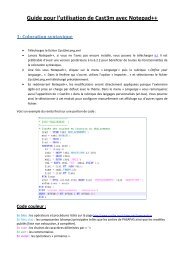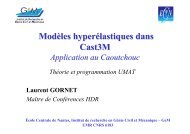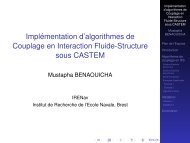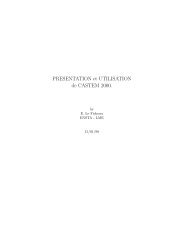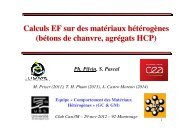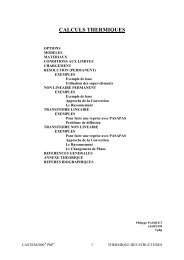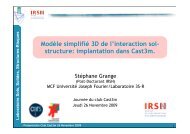Méthode XFEM pour la Modélisation de grandes ... - Cast3M - CEA
Méthode XFEM pour la Modélisation de grandes ... - Cast3M - CEA
Méthode XFEM pour la Modélisation de grandes ... - Cast3M - CEA
Create successful ePaper yourself
Turn your PDF publications into a flip-book with our unique Google optimized e-Paper software.
p<br />
Déformation p<strong>la</strong>stique cumulée ou équivalente<br />
P<br />
Force thermodynamique associée à l’écrouissage<br />
P ext<br />
Puissance <strong>de</strong>s actions extérieures<br />
P int<br />
Puissance <strong>de</strong>s actions intérieures<br />
r<br />
Rayon dans le repère <strong>de</strong> pointe <strong>de</strong> fissure<br />
R<br />
Rayon du cylindre<br />
R(p) Loi d’écrouissage du matériau sain<br />
R 0 et R m Rayon moyen initial et courant<br />
s zc<br />
Densité surfacique d’entropie <strong>de</strong> <strong>la</strong> zone cohésive<br />
(s i ) zc Densité surfacique d’énergie interne <strong>de</strong> <strong>la</strong> zone cohésive<br />
S, S 0 Surface courante et surface initiale<br />
S switch Section du cylindre au moment du switch<br />
t<br />
Temps<br />
T<br />
Température<br />
T 0<br />
Traction maximale<br />
u dl<br />
Norme du dép<strong>la</strong>cement imposé en bout <strong>de</strong> cylindre<br />
u h<br />
Dép<strong>la</strong>cement interpolé<br />
u i<br />
Degré <strong>de</strong> liberté standard au nœud i<br />
V ,V 0 Volume (courant) et volume initial<br />
W<br />
Travail <strong>de</strong>s efforts<br />
ω<br />
Fonction <strong>de</strong> pondération<br />
ω G<br />
Poids associé au point <strong>de</strong> gauss G<br />
ω R<br />
Erreur autorisée, Tolérance<br />
W ext Travail <strong>de</strong>s efforts extérieurs<br />
X, x Abscisse d’un point dans <strong>la</strong> configuration initiale, courante<br />
X a , x a Abscisse <strong>de</strong> <strong>la</strong> fissure dans <strong>la</strong> configuration initiale, courante<br />
γ<br />
Coefficient <strong>de</strong> chargement<br />
Γ 0<br />
Energie <strong>de</strong> rupture d’une zone cohésive<br />
Γ f<br />
Surface <strong>de</strong> <strong>la</strong> fissure<br />
Γ<br />
F<br />
Surface où l’effort est imposé<br />
Γ<br />
u<br />
Surface <strong>de</strong> dép<strong>la</strong>cement imposé<br />
Γ zc<br />
Surface <strong>de</strong> référence <strong>de</strong> <strong>la</strong> zone cohésive<br />
δ c<br />
Saut <strong>de</strong> dép<strong>la</strong>cement critique <strong>de</strong> <strong>la</strong> zone cohésive<br />
ζ<br />
Troisième direction dans le repère <strong>de</strong> l’élément <strong>de</strong> référence (élément<br />
parent)<br />
η<br />
Deuxième direction dans le repère <strong>de</strong> l’élément <strong>de</strong> référence (élément<br />
parent)<br />
θ<br />
Angle d’un point dans le repère <strong>de</strong> pointe <strong>de</strong> fissure<br />
λ<br />
1 er coefficient <strong>de</strong> Lamé<br />
λ &<br />
p<br />
Multiplicateur p<strong>la</strong>stique<br />
Λ R<br />
Multiplicateur <strong>de</strong> Lagrange associé au dép<strong>la</strong>cement <strong>de</strong> traction<br />
µ 2 ème coefficient <strong>de</strong> Lamé<br />
ν<br />
Coefficient <strong>de</strong> Poisson<br />
ρ, ρ 0 Masse volumique actuelle et initiale<br />
σ 0<br />
Limite d’é<strong>la</strong>sticité<br />
σ 1<br />
Paramètre du modèle <strong>de</strong> Rousselier<br />
σ m Contrainte moyenne : Tr (σ ) 3<br />
xii



